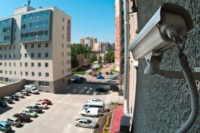Inventory loss through shoplifting or internal theft, unsuccessful in-store promotions, even long lines at the register – all of these are pain points for retailers and can seriously impact the bottom line.
As a key part of a loss prevention program, retailers have installed cameras to be the eyes in the store, acting as a deterrent through the very visible presence of the cameras mounted above registers, near doorways or in restricted areas. Of course, these cameras also present live and recorded images of potential situations that can be used to catch people in the act of committing a crime and serve as a forensic tool after the fact.
Because of the underlying concern about in-store shrinkage, retailers have made surveillance a priority through the adoption of basic video systems. Yet merchants are just now beginning to explore opportunities for video beyond security – something that can be achieved with the installation of IP camera technology.
According to a 2014 Centre for Retail Research survey on the use of CCTV video in U.K. retail settings, more than 60 percent of store operators who responded indicated they were planning to adopt network IP within the next three years, while one-third had already adopted it.
While addressing customer theft remained a major security challenge for retailers, respondents also cited preventing internal theft and better safety as reasons to improve their video systems. Additionally, those surveyed listed quality of image as an important reason for switching to network video.
But nearly half of the respondents also cited non-security applications, such as people counting and queue management for making the move to IP, noting these video-related tools could be used to improve sales and marketing.
It is apparent that IP video within retail stores can serve many purposes: So what are some of the ways in which retailers can best leverage network video?
Tracking and Apprehending In-Store Criminals
By deploying both in-camera intelligence and through the strategic positioning of highly functional IP cameras, in-store security can more easily identify and track a suspicious individual, such as suspected shoplifter, as the person moves throughout the store.
IP cameras have shown their ability to produce superior high-resolution images that increase the likelihood of producing a positive ID for a suspect. Improvements in technology related to latency have also stepped up camera response time, so personnel in the midst of an active surveillance situation can more easily follow someone’s movement and not lose sight of them as they travel among the views of different cameras in real time.
Not all in-store theft is generated by outside sources. Retailers are also using IP video to monitor employee actions, such as product going out the back door or never making it off the loading dock. Cameras positioned above registers provide a clear view of transactions, and the ability to zoom in and record images can offer evidence of a problem.
Internal theft is a major issue and one that IP video can help to address by linking cameras with point-of-sale (POS) data as well. By doing so, stores can view in real time or with recorded video suspicious behaviors such as no-sale rings on a register, or excessive returns in which cash is given to the customer.
Delivering Better Forensic Evidence
Not only are store’s seeking better quality images of suspects, but they also want to get that information as quickly as possible to share with police or to disperse systemwide so other stores within the chain can be aware of suspicious individuals. By deploying analytics within the camera or video management platform, store personnel can more easily pinpoint the important footage while bypassing hours of inconsequential video. Time and date stamps on the information can help make a better case against a suspect.
How is this achieved? It could be by sorting through the video using particular characteristics of the suspect – men wearing red shirts, or women pushing a stroller. Or the suspicious behavior could be identified by the entrance of a person into a restricted area as designed within the analytics, such as someone accessing the storage room or lingering outside an office door. Even simple motion search tools can be used to detect if someone is going the wrong way through an exit – this action can trigger the camera to record video and/or send an alert to security.
Reducing False Alarms
While the analytics can make note of an unusual behavior – such as entering through the exit – these activities are not always criminal. But by triggering a video alarm of the event, security staff can quickly check it out and see if, for instance, a child is playing with the automatic doors, which isn’t a true security risk. The same can be said for someone who may set off an alarm because an article surveillance tag was inadvertently left on an item that was sold. By marrying video with the article surveillance system the video can record that event and show that it is not someone leaving the store with an item, but rather entering the store, which means a theft isn’t likely underway.
Managing In-Store Displays and Promotions
Some of the newest video-related tools to be explored are related to movement within a store not associated to suspicious behaviors. Stores can certainly call out when someone is lingering where they shouldn’t be, or a package is left in a spot that speaks to a potential threat. That same dwell-and-linger and people-counting technology can be deployed to tell a merchant how often and for how long are people observing a particular display, or how many people are walking down a side aisle vs. a main one.
By gathering this kind of data, a retailer now has many tools at their disposal, whether it’s coming up with better signage because few people are stopping at a sale table, or reconsidering an in-store traffic pattern to prevent a bottleneck.
And long lines could be a thing of the past if retailers program their people-counting video analytics to tell them when more than four or more people are queuing at a register. With this information in hand, they can move sales personnel to the trouble spot, open another register or take other actions to address this issue.
Handling Surveillance Remotely
Whether it is sending video from an individual store back to a central headquarters location or store management viewing alerts on their phones, tablets and laptops, the advances in network IP video have made it possible to manage a situation as easily from a remote location as from within the store itself. This can save stores money on personnel and allow them to make better use of the people on site.
Instead of sitting in a backroom at a console watching video, a security officer can be walking the store and through an alert on his phone, can call up a video of the potential event to see whether he needs to respond in person, seek assistance from police or take no action at all because it was a false alarm.
As noted here, the opportunities presented by IP video are many and varied and will likely increase as more technologies, such as facial recognition, are married with the video analytics. Working in conjunction with IT staff to leverage the system, the IP video surveillance set up now becomes a tool that serves not only security but also the entire store.



